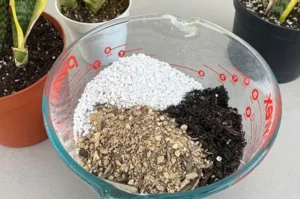Snake plants, also known as Sansevieria or Mother-in-Law’s Tongue, are popular for being low-maintenance. However, improper watering is one of the most common problems snake plant owners face. Too much or too little water can quickly lead to issues like yellowing leaves, root rot, or slow growth.
In this article, we’ll explore how to identify and solve watering problems with your snake plant.
1. Signs You’re Overwatering Your Snake Plant
One of the easiest mistakes to make is watering too often. Snake plants are succulents, meaning they store water in their leaves and don’t need frequent watering.
Signs of Overwatering:
- Yellow, mushy, or drooping leaves
- A musty or sour smell from the soil
- Roots that appear brown or black and mushy (root rot)
Solution:
- Stop watering immediately.
- Remove the plant from its pot and inspect the roots.
- Trim away any rotten roots and replant in fresh, dry, well-draining soil.
2. Signs of Underwatering
While snake plants are drought-tolerant, they still require occasional watering.
Signs of Underwatering:
- Dry, crispy, or curling leaves
- Brown leaf tips or edges
- Soil pulling away from the sides of the pot
Solution:
- Water the plant thoroughly and allow the soil to soak up moisture.
- Wait until the soil is dry again before the next watering.
3. Choosing the Right Soil and Pot
Even if you water correctly, poor soil or a pot without drainage can trap water and cause problems.
Best Practices:
✔ Use a well-draining soil mix (cactus or succulent mix).
✔ Select a pot with drainage holes.
❌ Avoid dense potting mixes or regular garden soil, as they hold too much water.
4. How Often Should You Water a Snake Plant?
There’s no one-size-fits-all watering schedule. It depends on season, humidity, temperature, and environment.
General Watering Guide:
- Summer: Every 2-3 weeks
- Winter: Once a month or less
Tip: Always check the soil before watering. Stick your finger one inch deep, if it feels dry, it’s time to water.
5. Using the Right Watering Technique
The way you water your snake plant matters!
Best Watering Practices:
✔ Water the soil directly, not the leaves.
✔ Water until it starts draining from the bottom.
✔ Discard excess water from the saucer to avoid root rot.
❌ Avoid misting, snake plants don’t need humidity, and wet leaves can lead to rot.
6. Adjusting Watering Based on Environment
Your plant’s location affects how often it needs water.
Factors That Affect Watering Frequency:
- Bright, warm rooms: Soil dries faster → water more often
- Dark, cool rooms: Soil stays moist longer → water less frequently
- Pot size: Smaller pots dry out faster than larger ones
Tip: Don’t water on a strict schedule, let the plant tell you when it’s thirsty!
Conclusion
Watering is one of the most important and tricky parts of caring for a snake plant. By learning to recognize the signs of overwatering or underwatering, and adjusting your care based on your plant’s needs, you’ll keep it healthy and thriving.
Tip: When in doubt, it’s better to underwater than overwater!






